Time: 9:30AM – 5:30PM
Location: Began at the boundary with private water just above MM10 and continued until .3 mile above the spring
Fish Landed: 29
Frying Pan River 09/11/2014 Photo Album
If I told you that I spent a full day on the Frying Pan River and did not encounter a significant hatch, you would probably assume that I experienced a slow day. Is this what happened on Thursday, September 11?
The Frying Pan River is my favorite stream in the state of Colorado, and the foremost reason for this ranking is the consistently reliable hatches that occur throughout the summer months and continuing into October. Wednesday was a bit frustrating as three mayflies hatched simultaneously, and I was largely unable to solve the riddle and catch fish consistently. Despite this circumstance the 1.5 hour hatch was still a period of excitement, and I looked forward to a similar event on Thursday. One of the negatives to the Frying Pan River is the presence of a large number of guides and fishermen in the upper 2.5 miles of public water below the dam.
I was frustrated with bumping into other anglers and the resultant infringement on my ability to move about, as my style of fishing is definitely to move often and avoid dwelling in one area. The Taylor Creek fishing report suggested that the three major mayflies were hatching from MM8 all the way to the dam, and I have had several superb days in the water between MM10 and MM11. I decided to give this area a try on Thursday.
Thursday morning remained cool, but warmer than Wednesday, and the high temperature would eventually climb to 70 degrees. In the morning I wore my Under Armour shirt and fleece along with my New Zealand billed hat with ear flaps, and I was comfortable until 11AM. When I ate lunch, I switched hats and removed my fleece layer, but by 3PM some clouds appeared, and it got quite breezy, so I pulled on my raincoat for the remainder of the day. The flows appeared to remain at 269 cfs as they were similar to Wednesday.
I began fishing just above the end of the private water near MM10 with a Chernobyl ant, salvation nymph, and RS2. In previous years I had success with the dry/dropper approach in the morning in this area, so I decided to test the approach one more time. I tossed the flies to a run in the narrow channel between the road and a tiny island, and a beautiful 15 inch brown hammered the Chernobyl ant. What a way to start my day!
From here I crossed to the side of the river away from the road and worked my way upstream prospecting all the likely pockets next to the overhanging branches and bushes. By 11:30 I had landed seven fish including a second fat 15 inch brown that came from a deep pocket along the bank. The RS2 that I began with was not producing, so I switched to a sunken black ant for a bit, and this actually yielded a small brown. The glow of the ant was short lived, however, so I switched to a beadhead hares ear as the top fly and moved the salvation nymph to the bottom position. The hares ear and salvation produced the other fish during the morning session.
After lunch I returned to just above the second island and fished back toward the spring along the left bank. In this area the left side of the river offered some deeper slots and pockets and appeared more attractive than the south shore. During this phase of my fishing adventure I added six more fish to my count including a large rainbow that slurped the Chernobyl ant and a chunky 14 inch brown from a short pocket next to the bushes that were tight to the bank.
When I reached the point where I was across from the Santa Fe and the spring, I began working my way across the river and prospected the pockets along the way. I glanced at my watch and noticed it was 1:30, and I was surprised that I wasn’t seeing any green drakes or other mayflies for that matter. With the lack of any surface activity, I continued with the dry/dropper approach, and why not with twelve fish in my tally including some sizable browns and rainbows?
In a pool in the center of the river I hooked a small brown that jumped on the Chernobyl ant. The tiny brown attempted to escape by spinning numerous times, and this created a massive tangle that involved all three flies. Even after clipping off the two nymphs, I couldn’t unravel the mess above the Chernobyl ant, so I cut everything off and rebuilt my leader. Somehow in the process of doing this and stuffing the waste mono in my front pack so as not to litter, I must have knocked my Simms velcro fly box into the water. When I realized it was not longer present, I scanned the water around me including current breaks that may have trapped a floating fly box. But this was all in vain, and I was heartbroken when I realized I lost an entire box of flies that I diligently tied. On Wednesday I had stuffed the Simms box with an assortment of green drakes and pale morning duns tied specifically for the Frying Pan River, and these were now gone. In addition it contained 15 size 12 stimulators that I made for Argentina and two or three pool toys along with two yellow sallies and three or four lime green trudes. The loss of the Frying Pan specific flies and the stimulators really hurt. I’m not typically superstitious, but I could not help thinking that the small brown was number thirteen.
Since I’d lost my carefully constructed cache of Frying Pan mayfly imitations, I returned to the car and searched through my backup bins. Unfortunately I discovered that only a couple size fourteen green drakes remained, so I grabbed them along with some larger versions and a few additional cinnamon comparaduns. It was at this time that I also pulled on my raincoat as a windbreaker.
I returned to the middle of the river, and since I needed to tie on new flies, I decided to prospect with a green drake despite not seeing any in the air. In the past I’ve had success with green drakes as a searching fly since the fish seem to have a long memory for these large morsels. I selected a comparadun style imitation with an exaggerated tall wing and began to cover the water around me. The strategy paid off in a short amount of time as I landed number 14, but then the lack of a good tailing material caused the large fly to sink quickly after drying, so I replaced it with a parachute green drake. This fly looked great on the water, but it quickly generated three refusals, so I was forced to reevaluate.
Since I still was not seeing naturals on the water or in the air, I decided to return to the dry/dropper approach, and only switch back to dries if I witnessed surface rises or an abundance of duns in the air. I tied on a tan pool toy, a beadhead hares ear, and a salvation nymph and began to prospect the pockets, riffles and runs on the right side of the river.
The remainder of the afternoon was simply insane. I methodically worked my way upstream along the right bank and popped casts of the three fly combination in all the likely pockets. I rarely cast more than ten feet out from the bank as I covered much more of the south side of the river than I’d ever attempted on previous visits to this area. The three fly combination was magical as I landed another fifteen trout to reach 29 on the afternoon. The salvation nymph was the most productive of the three, but the hares ear attracted enough fish to justify remaining on the line.
And what about the tan pool toy? For some reason it seemed to attract large rainbow trout. I landed three more bows in the 15-18 inch range during the late afternoon, and each one surprised me by raising a big nose out of the depths of a pocket to slurp the large buoyant foam grasshopper imitation. What a blast!
As I advanced further away from the spring, the riverbed narrowed, and I was forced to cast to the increasingly small pockets right along the bank. Nearly every spot that looked fishy yielded trout, and I totally blanked out any concerns about a mayfly hatch. In one rare deviation from working the edge I cast to a deep pocket toward the center of the river and something immediately attacked my fly. I executed a swift hook set and the aquatic missile bolted into the heavy current downstream and popped off all the flies including the pool toy. I surmise this may have been a foul hooked fish that refused the pool toy, and my quick hook set dragged a trailing nymph into its body.
I was now forced to tie on three new flies so I went to a tan Charlie Boy hopper with yellow legs as my top fly, and in an effort to preserve my dwindling supply of salvation nymphs, I knotted a beadhead pheasant tail to my leader as the bottom fly. I was pleased to discover that the pheasant tail produced reasonably well during its stay on my line; however, I still feel the salvation’s fish attracting capabilities were superior.
By 5:30 when I decided to call it a day, I had worked my way .3 miles above the spring, and this was farther than I’d ever ventured in the past, but the steady action continued until at least 5PM. Near the end of my fishing I approached a gorgeous riffle with some decent depth where the current angled away from the bank and back toward the center of the river. I flicked a cast into the head of the riffle and almost instantly the hopper darted sideways, and I responded with a reflexive hook set. As I fought a large rainbow, I spotted another rainbow of similar size chasing the fish I hooked. I never saw a fish chase another similar sized large fish like this in my many years of fly fishing.
On the day I landed 29 fish including five rainbows in the 15-18 inch range and 3-4 brown trout between 14 and 15 inches. In addition a bunch of wild healthy 12-13 inch browns found their way into my net along with some smaller browns to fill out the day. It was just an amazing afternoon. I never observed any consistently rising fish, but once I got on a roll with my dry/dropper approach, I never gave it a second thought. I do not know if the hatches had moved upstream or whether the lack of a hatch was weather related. I had the entire area to myself with no conflict with other fishermen to be concerned about. Thursday September 11 may have been my best day ever on the Frying Pan River.

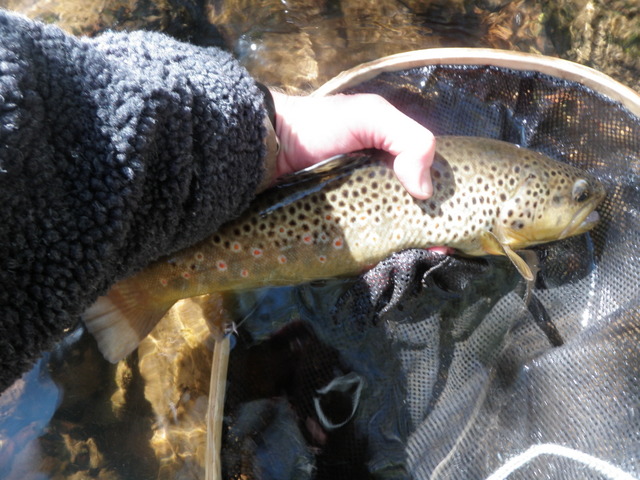
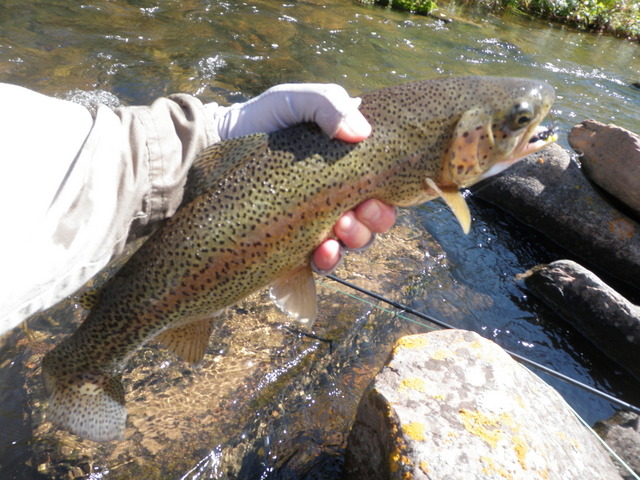
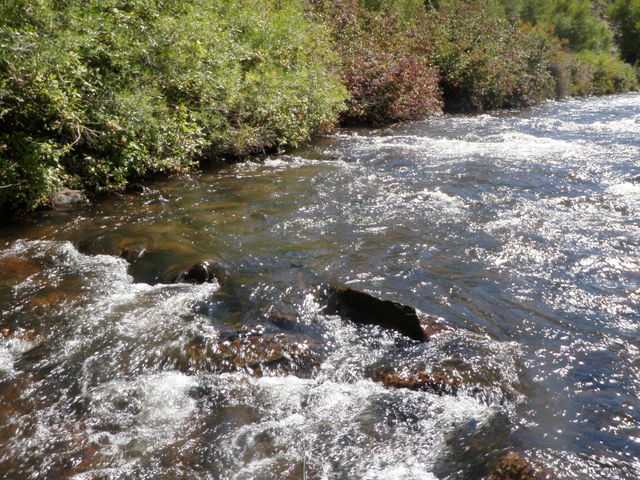
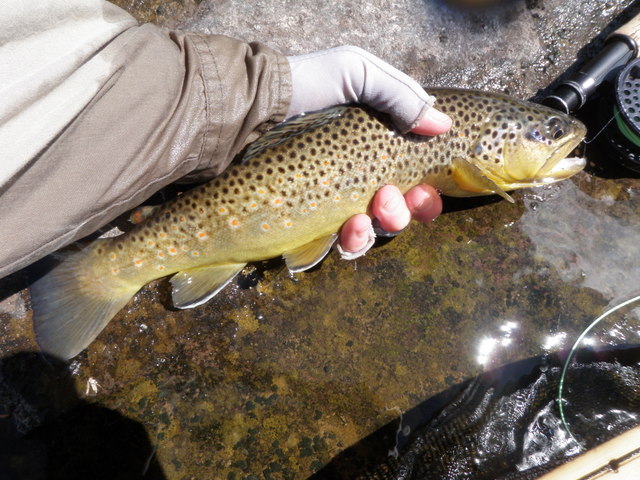
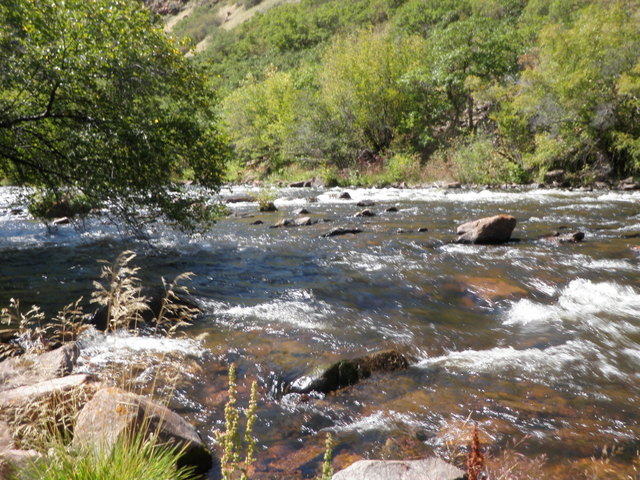
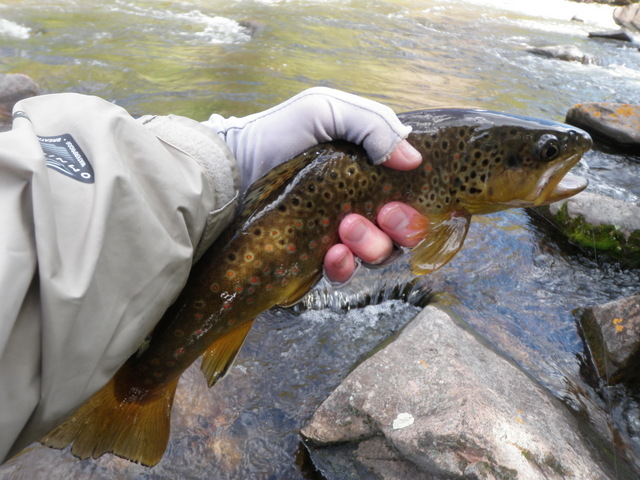
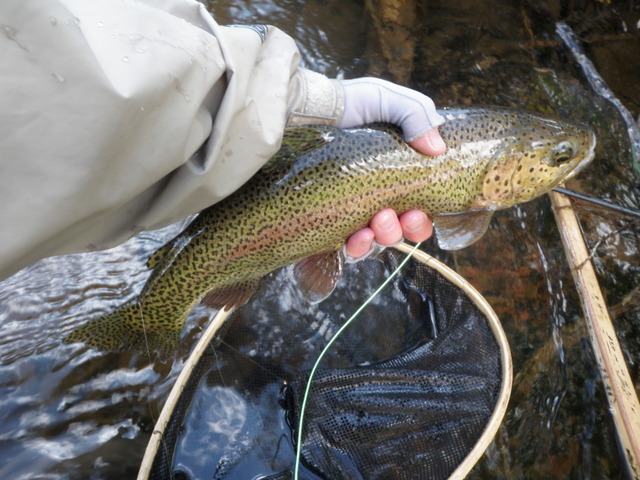
Dave – I was so excited to read your Frying Pan adventure and relive a few memories. I am so bummed for you that you lost a fly box… any fly fisherman’s worst nightmare (yet I still hurry to tie on a new fly and don’t close my pockets).
Lucky for you that you tie flies and can work to replenish. Best of luck with rest of the season. I’m sure we’ll be seeing you on skies shortly ! Say hello to Jane.
Dave
Dave – good to hear from you! I hope all is well I’m disappointed you haven’t paid us a visit in Colorado. Despite the loss of my fly box, it may have been my best day ever on the Pan in terms of quantity and size of fish. And all this despite the lack of any significant hatching activity in the area I was fishing.